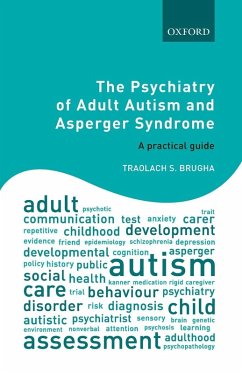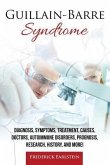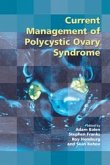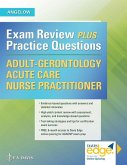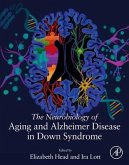- Broschiertes Buch
- Merkliste
- Auf die Merkliste
- Bewerten Bewerten
- Teilen
- Produkt teilen
- Produkterinnerung
- Produkterinnerung
The Psychiatry of Adult Autism and Asperger Syndrome: A practical guide introduces adult psychiatrists, including sub-specialist psychiatrists, to autism and Asperger syndrome.
Andere Kunden interessierten sich auch für
![Sjogren's Syndrome Sjogren's Syndrome]() Wan-Fai NgSjogren's Syndrome50,99 €
Wan-Fai NgSjogren's Syndrome50,99 €![Overactive Bladder Syndrome and Urinary Incontinence Overactive Bladder Syndrome and Urinary Incontinence]() Overactive Bladder Syndrome and Urinary Incontinence45,99 €
Overactive Bladder Syndrome and Urinary Incontinence45,99 €![A Guide to Adult Neuropsychological Diagnosis A Guide to Adult Neuropsychological Diagnosis]() Anthony Y. StringerA Guide to Adult Neuropsychological Diagnosis92,99 €
Anthony Y. StringerA Guide to Adult Neuropsychological Diagnosis92,99 €![Guillain-Barre Syndrome Guillain-Barre Syndrome]() Frederick EarlsteinGuillain-Barre Syndrome13,99 €
Frederick EarlsteinGuillain-Barre Syndrome13,99 €![Current Management of Polycystic Ovary Syndrome Current Management of Polycystic Ovary Syndrome]() Current Management of Polycystic Ovary Syndrome124,99 €
Current Management of Polycystic Ovary Syndrome124,99 €![Adult-Gerontology Acute Care Nurse Practitioner Adult-Gerontology Acute Care Nurse Practitioner]() Anthony M AngelowAdult-Gerontology Acute Care Nurse Practitioner80,99 €
Anthony M AngelowAdult-Gerontology Acute Care Nurse Practitioner80,99 €![The Neurobiology of Aging and Alzheimer Disease in Down Syndrome The Neurobiology of Aging and Alzheimer Disease in Down Syndrome]() The Neurobiology of Aging and Alzheimer Disease in Down Syndrome135,99 €
The Neurobiology of Aging and Alzheimer Disease in Down Syndrome135,99 €-
-
-
The Psychiatry of Adult Autism and Asperger Syndrome: A practical guide introduces adult psychiatrists, including sub-specialist psychiatrists, to autism and Asperger syndrome.
Produktdetails
- Produktdetails
- Verlag: Oxford University Press(UK)
- Seitenzahl: 268
- Erscheinungstermin: 1. März 2018
- Englisch
- Abmessung: 216mm x 140mm x 15mm
- Gewicht: 342g
- ISBN-13: 9780198796343
- ISBN-10: 019879634X
- Artikelnr.: 50499649
- Herstellerkennzeichnung
- Libri GmbH
- Europaallee 1
- 36244 Bad Hersfeld
- gpsr@libri.de
- Verlag: Oxford University Press(UK)
- Seitenzahl: 268
- Erscheinungstermin: 1. März 2018
- Englisch
- Abmessung: 216mm x 140mm x 15mm
- Gewicht: 342g
- ISBN-13: 9780198796343
- ISBN-10: 019879634X
- Artikelnr.: 50499649
- Herstellerkennzeichnung
- Libri GmbH
- Europaallee 1
- 36244 Bad Hersfeld
- gpsr@libri.de
Traolach S. Brugha is Professor of Psychiatry at University of Leicester and Consultant Psychiatrist at Leicestershire Partnership NHS Trust, Leicester, UK
* PART I. INTRODUCTION AND BACKGROUND
* 1: History and development of the concept of autism
* 2: Awareness of autism in adulthood
* 3: Development of behaviour and functioning (with hindsight)
* 4: Autism as a lived experience
* PART II. THE CLINICAL ASSESSMENT AND DIAGNOSTIC PATHWAY
* 5: Obtaining an assessment
* 6: Initial assessment ('Triage')
* 7: Full assessment: the developmental history
* 8: Full assessment: interviewing the patient and autistic
phenomenology
* 9: Full assessment: direct observation and the signs of autism
* 10: Comorbidity assessment
* 11: Detailed needs assessment
* PART III. CARE AND INTERVENTION AFTER DIAGNOSIS
* 12: Approaches to treatment and care
* 13: Social Care, the personal passport and reasonable adjustments
* 14: Caring communities and caring societies
* 15: Choices in life and the awareness, knowledge and skills to
support them
* References
* Appendices
* 1: Epidemiology Methods
* 2: The author's experiences in epidemiology and in policy development
* 3: Development of a new approach to interviewing adults about their
experiences of autism based on the Schedules for Clinical Assessment
in Neuropsychiatry (Chapter 8)
* 4: Independent evaluation of the ADOS in community populations
* Index
* 1: History and development of the concept of autism
* 2: Awareness of autism in adulthood
* 3: Development of behaviour and functioning (with hindsight)
* 4: Autism as a lived experience
* PART II. THE CLINICAL ASSESSMENT AND DIAGNOSTIC PATHWAY
* 5: Obtaining an assessment
* 6: Initial assessment ('Triage')
* 7: Full assessment: the developmental history
* 8: Full assessment: interviewing the patient and autistic
phenomenology
* 9: Full assessment: direct observation and the signs of autism
* 10: Comorbidity assessment
* 11: Detailed needs assessment
* PART III. CARE AND INTERVENTION AFTER DIAGNOSIS
* 12: Approaches to treatment and care
* 13: Social Care, the personal passport and reasonable adjustments
* 14: Caring communities and caring societies
* 15: Choices in life and the awareness, knowledge and skills to
support them
* References
* Appendices
* 1: Epidemiology Methods
* 2: The author's experiences in epidemiology and in policy development
* 3: Development of a new approach to interviewing adults about their
experiences of autism based on the Schedules for Clinical Assessment
in Neuropsychiatry (Chapter 8)
* 4: Independent evaluation of the ADOS in community populations
* Index
* PART I. INTRODUCTION AND BACKGROUND
* 1: History and development of the concept of autism
* 2: Awareness of autism in adulthood
* 3: Development of behaviour and functioning (with hindsight)
* 4: Autism as a lived experience
* PART II. THE CLINICAL ASSESSMENT AND DIAGNOSTIC PATHWAY
* 5: Obtaining an assessment
* 6: Initial assessment ('Triage')
* 7: Full assessment: the developmental history
* 8: Full assessment: interviewing the patient and autistic
phenomenology
* 9: Full assessment: direct observation and the signs of autism
* 10: Comorbidity assessment
* 11: Detailed needs assessment
* PART III. CARE AND INTERVENTION AFTER DIAGNOSIS
* 12: Approaches to treatment and care
* 13: Social Care, the personal passport and reasonable adjustments
* 14: Caring communities and caring societies
* 15: Choices in life and the awareness, knowledge and skills to
support them
* References
* Appendices
* 1: Epidemiology Methods
* 2: The author's experiences in epidemiology and in policy development
* 3: Development of a new approach to interviewing adults about their
experiences of autism based on the Schedules for Clinical Assessment
in Neuropsychiatry (Chapter 8)
* 4: Independent evaluation of the ADOS in community populations
* Index
* 1: History and development of the concept of autism
* 2: Awareness of autism in adulthood
* 3: Development of behaviour and functioning (with hindsight)
* 4: Autism as a lived experience
* PART II. THE CLINICAL ASSESSMENT AND DIAGNOSTIC PATHWAY
* 5: Obtaining an assessment
* 6: Initial assessment ('Triage')
* 7: Full assessment: the developmental history
* 8: Full assessment: interviewing the patient and autistic
phenomenology
* 9: Full assessment: direct observation and the signs of autism
* 10: Comorbidity assessment
* 11: Detailed needs assessment
* PART III. CARE AND INTERVENTION AFTER DIAGNOSIS
* 12: Approaches to treatment and care
* 13: Social Care, the personal passport and reasonable adjustments
* 14: Caring communities and caring societies
* 15: Choices in life and the awareness, knowledge and skills to
support them
* References
* Appendices
* 1: Epidemiology Methods
* 2: The author's experiences in epidemiology and in policy development
* 3: Development of a new approach to interviewing adults about their
experiences of autism based on the Schedules for Clinical Assessment
in Neuropsychiatry (Chapter 8)
* 4: Independent evaluation of the ADOS in community populations
* Index

